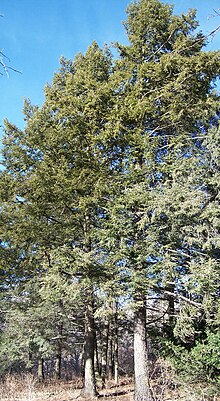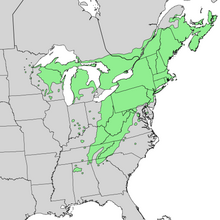Eastern hemlock
| Tsuga canadensis | |
|---|---|
 |
|
| Large specimens at Morton Arboretum | |
| Scientific classification | |
| Kingdom: | Plantae |
| Division: | Pinophyta |
| Class: | Pinopsida |
| Order: | Pinales |
| Family: | Pinaceae |
| Genus: | Tsuga |
| Species: | T. canadensis |
| Binomial name | |
|
Tsuga canadensis (L.) Carrière |
|
 |
|
| Natural range | |
 |
|
| Closeup view of range | |
Tsuga canadensis, also known as eastern hemlock,eastern hemlock-spruce or Canadian hemlock, and in the French-speaking regions of Canada as pruche du Canada, is a coniferous tree native to eastern North America. It is the state tree of Pennsylvania.
The eastern hemlock grows well in shade and is very long lived, with the oldest recorded specimen, found in Tionesta, Pennsylvania, being at least 554 years old. The tree generally reaches heights of about 31 meters (102 feet), but exceptional trees have been recorded up to 53 meters (174 feet). The diameter of the trunk at breast height is often 1.5 meters (4 feet 11 inches), but again, outstanding trees have been recorded up to 1.75 meters (5 feet 9 inches). The trunk is usually straight and monopodial, but very rarely is forked. The crown is broadly conic, while the brownish bark is scaly and deeply fissured, especially with age. The twigs are a yellow-brown in colour with darker red-brown pulvini, and are densely pubescent. The buds are ovoid in shape and are very small, measuring only 1.5 to 2.5 mm (1⁄16 to 3⁄32 in) in length. These are usually not resinous, but may be slightly so.
The leaves are typically 15 to 20 mm (9⁄16 to 13⁄16 in) in length, but may be as short as 5 mm (3⁄16 in) or as long as 25 mm (1 in). They are flattened and are typically distichous, or two-ranked. The bottom of the leaf is glaucous with two broad and clearly visible stomatal bands, while the top is a shiny green to yellow-green in colour. The leaf margins are very slightly toothed, especially near the apex. The seed cones are ovoid in shape and typically measure 1.5 to 2.5 cm (5⁄8 to 1 in) in length and 1 to 1.5 cm (3⁄8 to 5⁄8 in) in width. The scales are ovate to cuneate in shape and measure 8 to 12 mm (5⁄16 to 1⁄2 in) in length by 7 to 10 mm (1⁄4 to 3⁄8 in) in width. The apex is more or less rounded and is often projected outward. Twenty-four diploid chromosomes are present within the trees' DNA.
...
Wikipedia

